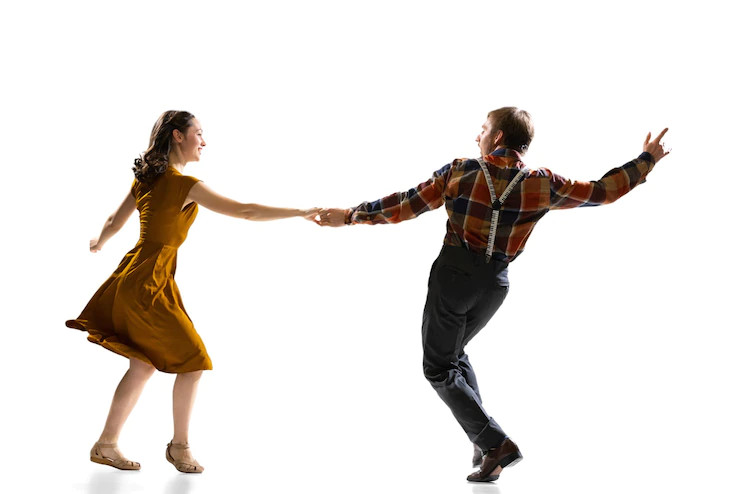Swing dancing has been around for nearly 100 years.
Since the Jazz Age in the 1920s, swing dancing has grown to include a long list of dances, making it difficult for beginners to learn where to start.
Here are eight of the most popular types of swing dancing that are perfect for beginners.
Types of swing dance
1. Lindy dance
Lindy dance is a must-learn swing dance for beginners, and many swing dances are based on Lindy dance.
Originating in the 1930s, the Lindy Hop is named after pilot Charles Lindbergh and his flight across the Atlantic.
Lindy Hop includes both six- and eight-beat patterns with lots of flips, kicks, and swings.
Performing lindy dance requires a lot of movement on the dance floor and is often associated with swing dancing.
2. Balboa
Balboa is another original swing dance developed in the 1920s.
It originated in Southern California due to smaller dance halls with limited space and a more conservative attitude in the area.
Unlike Lindy Hop, Balboa doesn't have big kicks, spins or turns.
The dancer holds the closed position in an upright position.
3. Shag
The Shag was introduced in the Carolinas in the 1920's and spread across the country over the next decade.
It was one of the most popular swing dances of its time and was often performed to fast-paced music.
Shag primarily uses a six-beat pattern and complex footwork.
However, there are several variations of the Shag, including the Carolina Shag, St. Louis Shag, and Collegiate Shag.
4. Six-beat variation of East Coast Swing
Lindy Dance, simple structure, suitable for beginners to learn swing dance.
The East Coast Swing can also play slow, medium or fast songs.
5. West Coast Swing
Like East Coast Swing, West Coast Swing is a versatile dance suitable for a variety of musical genres, including jazz, blues, pop, hip-hop, and rock.
It is also a variation of Lindy Hop, but originated in dance halls around the Los Angeles area on the West Coast.
6. Jive
Jive is an upbeat dance that evolved from Eastern Swing after the arrival of US troops in Britain during World War II.
It dances to fast-paced music, featuring turns, spins and kicks.
7. Boogie-Woogie
Boogie-Woogie originated in the 1940s.
Unlike most other swing dances, Boogie-Woogie is not for jazz.
The dance comes from boogie-woogie music, which is a form of the blues.
It focuses more on footwork, often in a six-beat pattern.
8. Jitterbug
Jitterbug is probably the most famous and misunderstood swing dance.
Over the years, the name "Jitterbug" has been used to refer to a variety of swing dancing styles.
However, it is now generally recognized as a single-rhythm variation on East Coast swing.
These are just some of the most popular types of swing dancing.
After learning everything from Lindy Hop to Jitterbug, you may find it easier to learn new dances and expand your dance floor.
9. Hand Dance
DC Hand Dance is a swing dance that arose in Washington, DC in the 1950s, out
of the Lindy Hop, Jitterbug, and other swing dances of the '20s and '30s.
While Hand Dancing is still primarily a local dance practice in northern Maryland and as far south as Virginia, it has been seen by many West Coast swing dancers.
Historically, the name "Hand Dance" comes from the return of the Neo-Swing in the 1990s.
However, it started in the United States. Different styles are happening worldwide, for example, in Germany, England and France, Brazil, Australia and New Zealand.
main styles are:
East Coast Swing
West Coast Swing Lindy hop
North Dallas
Push Houston
whip Carolina
Shag
Collegiate Shag
St. Louis Shag
Bop
Hand Dancing
Swing-Out
Among them, what about jitterbug?
Jitterbug is not a special dance. It is an umbrella term for all fast swing styles.
When you hear someone say jitterbug, it will be viewed differently in Maryland than someone saying jitterbug in California.
The three main styles are West Coast Swing, East Coast Swing, and Lindy-dancing throughout the United States and around the world.
Types of Swing Dancing Summary
As you can see, swing dancing is a type of backup dance that emerged in the 1920s.
There are many types of swing dancing, each with its own unique style.
For example, East Coast Swing focuses on footwork, while West Coast Swing emphasizes fluidity and improvisation.
Lindy Hop is known for its fast tempos, while Charleston features intricate dance moves and flamboyant turns.










